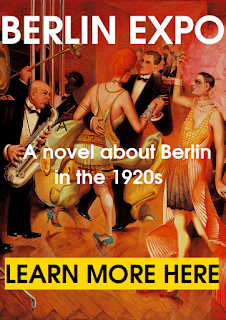The Capitol by the zoo was a movie theater built in 1925/26 by Hans Poelzig with around 1300 seats. It was part of a low long building, a two-storey row of shops in a functional, modern style and in extreme contrast to the neo-Romanesque pomp of the buildings around Auguste-Viktoria-Platz (Kaiser-Wilhelm-Gedächtniskirche, the two romanesque houses, Gloria-Palast and Ufa-Palast am Zoo). The functional exterior was also in contrast with the expressionistic interior of the theatre. Above a high attic, a recessed octagonal structure with the name was used for advertising. The interior was designed in an Expressionist manner: in the almost square entrance foyer there was a free-standing oval ticket booth in the middle, surrounded by concentrically arranged, irregularly cut, differently colored marble slabs. The hexagonal cinema hall was closed off by a high, octagonal ceiling lined like a marquee above a low gallery. The coloring was graded from deep violet to violet-red, golden brown, ocher to light Indian yellow from bottom to top. With an organ and a retractable orchestra pit, the Capitol was one of the most impressive cinemas of its time. It was destroyed in an air raid in 1943. In 1955-57 the Bikini House was built in its place as part of the Zentrum am Zoo. (info from https://www.berlin.de/)
Illuminated advertising was thoroughly researched and used to emphasize the long, low lines of the building. The name of the cinema flashed in four different colours. The fact that the cinema was part of a whole shopping complex limited Poelzig's freedom of design but he made an extremely creative use of the possibilities allowed to him, squeezing for instance, four spiral staircases at each corner of the auditorium to counterbalance the narrowness of the entrance foyer and giving thereby an expressionistic feeling to the whole.
The building became, in its inner layout, a victory over the severe conditions imposed upon it. The auditorium is very impressive too; the plaster lines emanating from the central lighting complex like sun-rays continue down the ceiling and down the walls to the ground.
The architecture historian Wolfgang Pehnt writes:
"In the Capitol cinema there was still a hint of that enigmatic, demon-peopled world which the expressionist film had conjured up - in the odd curve of the staircase, in their intersections with the tunnel-vaulted passages, and also in the tent-like, fluted ceiling of reinforced plaster".
"The nearby Capitol am Zoo on Budapester Strasse, designed by Hans Poelzig and opened in December 1925, was Ufa-Palast's counterweight. Poelzig, who, like Gropius, belonged to the reform wing of the German Workers League, had been regarded as an able theater architect ever since he had converted the Schumann Circus into the Grosses Schauspielhaus. Two years after the Capitol he built the Deli-Kino in Breslau, and in 1929 he was the architect for the Berlin Babylon. His original draft for the Capitol called for a design somewhere "between a functionalistic office building and a pathos-laden, neoclassical embassy." Despite major changes, the facade retained the classical clarity of its horizontal lines, and it offered impressive possibilities for neon lighting. As in the Grosses Schauspielhaus, Poelzig showed himself an expert with interior lighting – where light rays spread out from the center of the dome, adding an especially appropriate touch for a movie house. Functional but not boring, the Capitol represented a counterpoint for the overworked eclecticism of the neighboring Ufa cathedrals.
"The Capitol, which had about 1,300 seats, steered a different course with premieres, too. February 1926 saw the German premiere of Charlie Chaplin's The Gold Rush, with a prologue spoken by Curt Bois. Chaplin's Circus followed in 1928. The Capitol also showed Gerhard Lamprecht's socially concerned films Die Unehelichen (The Illegitimate Children, 1926) and Der Katzensteg (The Catwalk, 1927), based on the novel of the same title by Hermann Sudermann. In 1926 it screened Henrik Galeen's remake of The Student of Prague with sets by Hermann Warm and Conrad Veidt in the starring role that Paul Wegener had played in 1913. And with tear-jerkers like Wilhelm Dieterle's Die Heilige und ihr Narr (The Saint and Her Fool, 1928), based on the pulp novel by Agnes Günther, the Capitol made its concessions to the taste of "little shopgirls," who found "unimagined insights into the wretchedness of humanity and the goodness dispensed from above."
(from The Ufa Story, A History of Germany's Greatest Film Company 1918-1945, by Klaus Kreimeier, University Of California Press )
Other films that premiered at Capitol in 1930-1931 were: Berlin Alexanderplatz by Phil Jutzi, Pabst's Kameradschaft and The other by Robert Wiene.
There were several main cinemas around the Gedächtniskirche. 1: Ufa Palast am Zoo, 2: Gloria-Palast, 3:
Capitol am Zoo, 4: Marmorhaus, 5: Romanische Café, 6: Zoo-station, 7:
the Zoo.















No comments:
Post a Comment